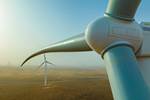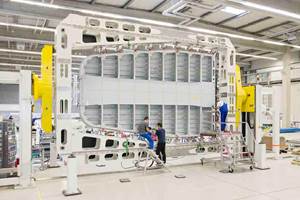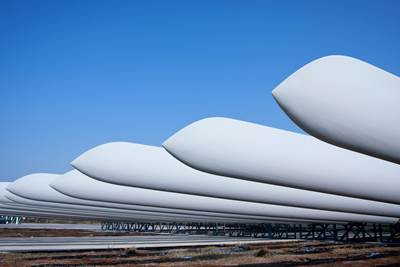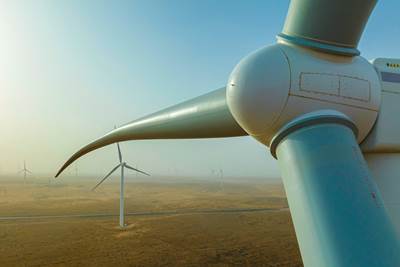Vestas unveils circularity solution to end landfill for turbine blades
A novel chemical process, developed within the CETEC initiative with partners Olin and Stena Recycling, is capable of breaking down epoxy resin to virgin-grade material.
Photo Credit: Getty Images
Vestas Wind Systems A/S (Aarhus, Denmark) is presenting a new solution that renders epoxy-based wind turbine blades as circular, without the need for changing the design or composition of the blade material. Combining newly discovered chemical technology developed within the CETEC initiative, and partnerships with Olin (Clayton, Mo., U.S.) and (Frogner, Norway), the solution can be applied to blades currently in operation. Once matured, Vestas says this will eliminate the need for blade redesign, or landfill disposal of epoxy-based blades when they are decommissioned.
“Until now, the wind industry has believed that turbine blade material calls for a new approach to design and manufacture to be either recyclable, or beyond this, circular, at end of life,” Lisa Ekstrand, vice president and head of sustainability at Vestas, says. “Going forward, we can now view old epoxy-based blades as a source of raw material. Once this new technology is implemented at scale, legacy blade material currently sitting in landfill, as well as blade material in active wind farms, can be disassembled, and reused. This signals a new era for the wind industry, and accelerates our journey towards achieving circularity.”
Turbine blades have previously been challenging to recycle due to the chemical properties of epoxy resin, a resilient substance that was believed to be impossible to break down into reusable components. This has led to many technology leaders attempting to replace or modify epoxy resin with alternatives that can be more easily treated. Vestas’ solution is enabled by a novel chemical process that can chemically break down epoxy resin into virgin-grade materials. The chemical process was developed in collaboration with Aarhus University (Denmark), Danish Technological Institute (Taastrup) and Olin the partners of the CETEC project, a coalition of industry and academia established to investigate circular technology for turbine blades.
“The newly discovered chemical process shows that epoxy-based turbine blades, whether in operation or sitting in landfill, can be turned into a source of raw material to potentially build new turbine blades,” Mie Elholm Birkbak, specialist, innovation and concepts at Vestas, adds. “As the chemical process relies on widely available chemicals, it is highly compatible for industrialization, and can therefore be scaled up quickly.”
WindEurope expects around 25,000 tonnes of blades to reach the end of their operational life annually by 2025.
Through a newly established value chain, supported by Nordic recycling company Stena Recycling and global epoxy manufacturer Olin, Vestas will now focus on scaling up the novel chemical disassembly process into a commercial solution. Once mature, the solution will signal the beginning of a circular economy for all existing, and future epoxy-based turbine blades.
For several decades, producing wind turbine blades manufactured with epoxy-based resin has been standard practice in the wind industry. In the most mature markets for wind energy, the first turbines are reaching the end of their operational life and this will increase over the coming years.
In addition, the new solution will provide Vestas with the opportunity to produce new turbine blades made from reused blade material. In the future, the new solution also signals the possibility to make all epoxy-based composite material a source of raw material for a broader circular economy, potentially encompassing industries beyond wind energy.
Related Content
From the CW Archives: Airbus A400M cargo door
The inaugural CW From the Archives revisits Sara Black’s 2007 story on out-of-autoclave infusion used to fabricate the massive composite upper cargo door for the Airbus A400M military airlifter.
Read MorePlant tour: Collins Aerospace, Riverside, Calif., U.S. and Almere, Netherlands
Composite Tier 1’s long history, acquisition of stamped parts pioneer Dutch Thermoplastic Components, advances roadmap for growth in thermoplastic composite parts.
Read MoreCombining multifunctional thermoplastic composites, additive manufacturing for next-gen airframe structures
The DOMMINIO project combines AFP with 3D printed gyroid cores, embedded SHM sensors and smart materials for induction-driven disassembly of parts at end of life.
Read MoreAssembling the Multifunctional Fuselage Demonstrator: The final welds
Building the all-thermoplastic composite fuselage demonstrator comes to an end with continuous ultrasonic welding of the RH longitudinal fuselage joint and resistance welding for coupling of the fuselage frames across the upper and lower halves.
Read MoreRead Next
Continuum targets facility capacity, transforms composite materials to advance wind blade recycling
The Denmark company details a CO2-neutral transformation technology to make 100% recyclable wind blades, plans to build six recycling facilities.
Read MoreSwancor, Siemens Gamesa collaborate on advancing recyclable wind blade technologies
Through Swancor’s recyclable thermosetting resin technologies, the recyclable resin and composites can be reused, assisting Siemens Gamesa in moving towards its goal of providing fully recyclable wind turbines in Taiwan.
Read MoreCeramic matrix composites: Faster, cheaper, higher temperature
New players proliferate, increasing CMC materials and manufacturing capacity, novel processes and automation to meet demand for higher part volumes and performance.
Read More












